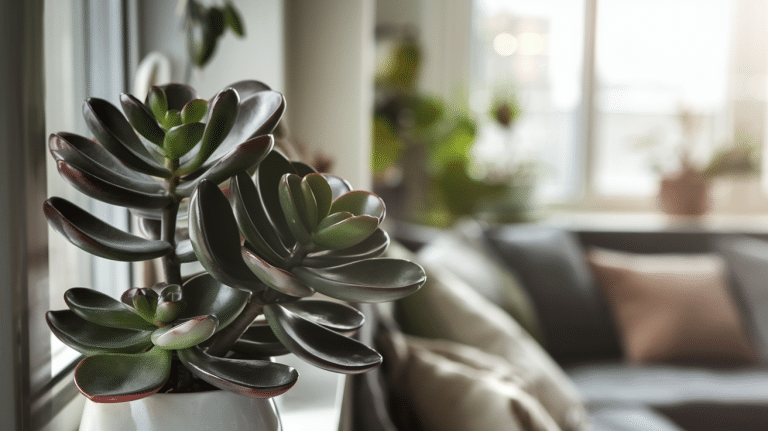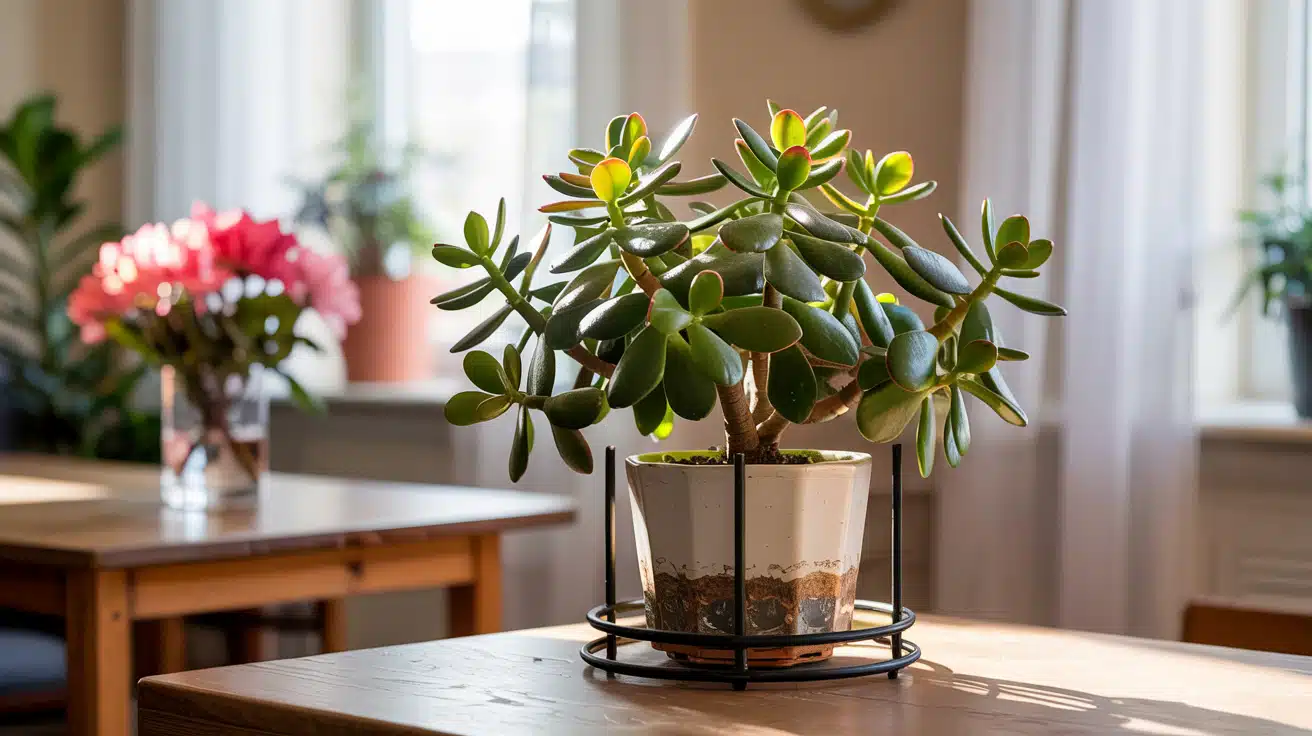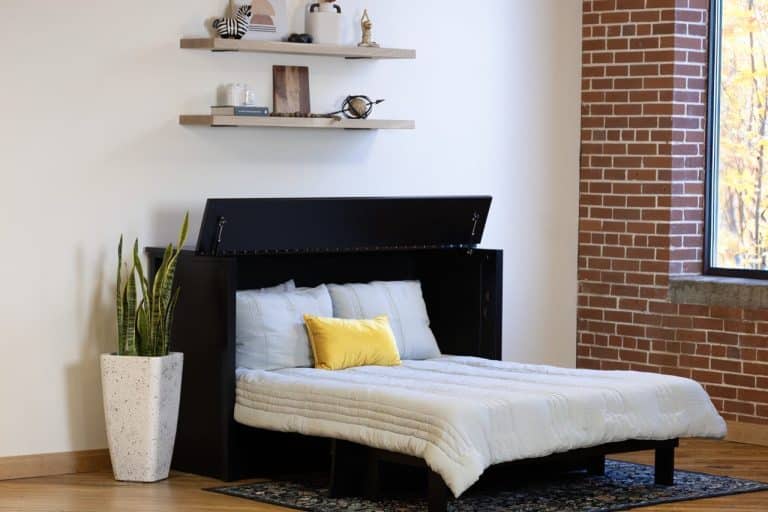The jade plant, also known as Crassula ovata, comes from South Africa and Mozambique.
Known by many names—jade plant, money plant, or lucky plant—this small green friend plays a big role in many homes.
People all over the world keep these plants for their good looks and the belief that they bring wealth and good fortune.
Jade plants have become popular because they’re so easy to care for.
In this blog, we’ll discuss Crassula ovata, its many benefits, basic care tips, common problems, and solutions.
By the end, you’ll have all the know-how to help your jade plant grow strong and healthy for years to come.
What is Crassula ovata?
Crassula ovata is a common house plant many people call jade plant, lucky plant, or money plant.
This plant has thick, waxy leaves that store water. The leaves are round, fleshy, and dark green, sometimes with red edges.
When grown in good conditions, a full-grown jade plant can reach 3 to 6 feet tall. Its woody stem looks like a small tree trunk. The plant grows small pink or white flowers, though this doesn’t happen often when kept indoors.
Common Varieties
There are several types of jade plants you might find:
- Regular Jade (Crassula ovata): Has oval-shaped, flat leaves
- Gollum Jade: Has tubular leaves with a slight curl at the tips, like small trumpets
- Hobbit Jade: Similar to Gollum but with leaves that have a more obvious curl
- Hummel’s Sunset: Has golden-yellow leaves with red tips
- Baby Jade: A smaller version of the standard jade plant
Each type has its look but needs similar care. These plants are popular because they don’t need much attention to stay healthy and can live for many years when cared for correctly.
Jade plants are part of the Crassulaceae family, which includes about 300 different plant types. They work well as indoor plants in most homes and can be good plants for beginners.
Benefits of Jade Plants
Jade plants bring more than good looks to your home. These small but mighty plants offer several benefits for your space and your well-being.
Good Luck and Prosperity
Many people think of jade plants as symbols of good luck. In some Asian cultures, they’re called “money plants” or “lucky plants” because people believe they bring wealth and success.
Some people put them near the entrance of their homes or businesses to welcome good fortune.
In feng shui practices, jade plants are thought to create positive energy when placed in certain areas of your home or office. Their round leaves are said to look like coins, which connects them to the idea of growing wealth.
Health Advantages
Jade plants can help clean your indoor air. Like other plants, they take in carbon dioxide and give off oxygen, which helps freshen the air you breathe.
Having plants like jade in your living or working space might help lower stress. Caring for plants can be calming, and seeing green, living things in your home can help you feel more at ease.
Jade plants are also great for busy people or those who sometimes forget to water their plants. Since they store water in their leaves, they can go without watering for longer periods than many other plants.
These plants need little care but offer many good things in return. They can live for many years and are sometimes passed down through families as living gifts.
How to Care for Crassula Ovata
Taking care of a jade plant is simple once you know the basics. These tough plants can last for years with the right care. Here’s what you need to know to keep your jade plant happy and healthy.
1. Watering

Jade plants don’t need much water. They store water in their thick leaves, so it’s better to water less than more.
Water only when the soil is completely dry – in summer, this might be every 1-2 weeks, while in winter, cut back to once a month or less.
Use the “soak and dry” method – water it deeply until it runs out to the bottom, then let it dry out fully.
Signs of overwatering include soft, mushy leaves that fall off easily and yellow, transparent leaves.
Signs of underwatering include wrinkled, shriveled leaves, brown leaf tips, and slow growth.
A good tip is to check the soil with your finger – if it feels dry 1-2 inches down, it’s time to water.
2. Light
Jade plants love light but can get sunburned. Place in bright, indirect light for most of the day.
Morning direct sun is good, but avoid hot afternoon sun. Look for south or west-facing windows for best results.
Plants with too little light become “leggy” with stretched stems. Leaves might turn red on the edges when they get enough light – this is normal and healthy.
Rotate your plant every few weeks so all sides get equal light.
3. Soil and Fertilizer

The right soil helps prevent root rot and keeps your jade plant strong. Use cactus or succulent soil mix with added perlite or coarse sand for better drainage.
Make sure pots have drainage holes. Terracotta pots work well as they allow soil to dry out.
For fertilizer, feed during the growing season (spring and summer) using a balanced, water-soluble fertilizer at half-strength.
Apply every 2-3 months, but don’t fertilize in fall or winter when growth slows down.
4. Temperature and Humidity

Jade plants come from South Africa and like similar conditions. Keep between 65-75°F (18-24°C) during the day.
They can handle cooler nights down to 55°F (13°C) but need protection from cold drafts and frost.
These plants prefer normal to dry home humidity, so there’s no need for misting or humidifiers. This makes them perfect for most indoor spaces.
5. Pruning

Pruning helps shape your jade plant and keeps it healthy. The best time to prune is early spring using clean, sharp scissors or pruning shears.
Cut just above a leaf node (where leaves meet the stem) and remove any dead or damaged parts. Don’t remove more than 20-30% of the plant at once.
Save the cuttings to grow new plants! Let them dry for a few days, then plant them in dry soil. Don’t water until you see new growth.
With these simple care tips, your jade plant can thrive for decades and might even grow into a small tree-like shape over time.
Troubleshooting Problems Related to Crassula Ovata
Even the toughest plants face problems sometimes. Jade plants are strong, but they can still run into issues. Here are some common problems you might see with your jade plant and how to fix them.
1. Overwatering
This is the most common problem jade plant owners face. Too much water causes the roots to rot, which can kill your plant if not fixed quickly.
If you notice soft, mushy leaves or stems that feel squishy when touched, your plant is likely overwatered. Stop watering right away and check the roots. Remove the plant from its pot and look for black or brown mushy roots – these are rotting.
To fix an overwatered jade:
- Remove the plant from wet soil
- Cut away any rotting roots with clean scissors
- Let the plant dry out for 2-3 days
- Repot in fresh, dry cactus soil
- Wait a week before watering again
2. Pest Problems
Jade plants can attract mealybugs, spider mites, and scale insects. These tiny bugs suck the sap from your plant and weaken it over time.
Mealybugs look like small white cotton balls on stems and leaves. Spider mites are tiny and create fine webs between leaves. Scale looks like small brown bumps stuck to stems.
To get rid of pests:
- Wipe the leaves with a cotton ball dipped in rubbing alcohol
- Spray the plant with a mix of water and mild soap
- For bad cases, use neem oil following package directions
- Keep the plant away from other plants until pests are gone
3. Yellowing Leaves
Yellow leaves on a jade plant usually mean something is wrong with the water, light, or nutrients.
If the older, bottom leaves turn yellow and fall off, this might be normal aging. But if many leaves turn yellow at once, check these possible causes:
Too much water: Yellow, mushy leaves that fall off easily Too little light: Pale yellow leaves and stretched stems Nutrient problems: Yellow leaves with green veins
The fix depends on the cause. Cut back watering, move to a brighter spot, or try a light feeding with half-strength plant food.
4. Dropping Leaves
Jade plants drop leaves when stressed. This can happen after a move to a new spot or when seasons change.
A few falling leaves aren’t a big worry, but if your plant loses many leaves at once, look for these causes:
Temperature shock: Keep away from cold drafts, heaters, and AC vents Dry air: While jades like it on the dry side, very dry air can stress them Physical damage: Bumping or moving the plant often can cause leaf drop
Give your plant a steady spot with good light and a regular care routine. Once it gets used to its new home, it should stop dropping leaves.
Remember that jade plants are tough, and most problems can be fixed with simple changes to their care. When in doubt, it’s usually better to do less rather than more when it comes to watering and feeding these hardy plants.
How to Propagate Crassula Ovata
Taking Leaf Cuttings
One of the easiest ways to grow a new jade plant is from a single leaf:
- Choose a healthy, plump leaf and gently twist it off the stem with a slight sideways motion
- Let the leaf dry and form a callus at the base (where it was attached to the stem) for 3-5 days
- Place the callused end on top of dry cactus soil
- Don’t water yet! Wait until you see tiny roots or a small plant forming at the base
- Once new growth appears (usually 2-4 weeks), give a light watering around the roots
Leaf cuttings take longer to grow into full plants but are a fun way to see how jade plants develop from the very beginning.
Taking Stem Cuttings
For faster results, stem cuttings are your best option:
- Select a healthy stem segment about 2-4 inches long
- Cut it with clean, sharp scissors or a knife
- Remove the lower leaves, leaving 2-3 sets at the top
- Let the cut dry for 5-7 days until the cut end forms a callus
- Stick the callused end about 1 inch deep in dry cactus soil
- Wait 2-3 weeks before watering lightly
The stem cutting will develop roots in a few weeks. You might see new leaves forming at the top even before the roots are established.
Caring for New Plants
Young jade plants need a bit more attention than mature ones:
- Place new plants in bright but indirect light
- Water more lightly than adult plants, but don’t let them dry out completely
- Wait at least 6 months before applying any fertilizer
- Keep them in small pots until they outgrow them – jade plants like to be a bit crowded
New plants from cuttings should start to look like mini versions of the parent plant within 6-12 months. The key to success is patience – jade plants grow slowly but steadily.
When to Repot Young Jades
You’ll know it’s time to move your young jade to a slightly larger pot when:
- You see roots coming out of the drainage holes
- The plant becomes top-heavy and tips over easily
- Growth slows down even during spring and summer
Choose a pot only 1-2 inches larger than the current one. Too much soil around the roots can lead to overwatering problems.
With these simple steps, you can grow many new jade plants over time. Their ease of propagation is one of the reasons these plants have been popular houseplants for generations.
Placement and Styling Tips for Jade Plants
Finding the right spot for your jade plant can help it grow well and look its best. These plants add a touch of green to many different rooms in your home or workplace.
Best Locations
Jade plants do well in areas with good light but not too much direct sun. They thrive near south or west-facing windows where they get bright light but are protected from hot afternoon sun.
Side tables in living rooms, desks in home offices, and kitchen counters away from heat sources all make good spots. Avoid bathrooms, dark corners, and areas near heater vents or air conditioners.
Jade plants stand out on their own or grouped with other succulents, thanks to their tree-like shape.
Feng Shui Placement

In feng shui practices, jade plants are thought to bring good fortune and wealth. The southeast area of your home or office is linked to wealth and is ideal for jade plants.
Placing them near entrances is said to welcome good energy, while home offices or work spaces are popular spots to bring success in business. The east side supports family health and growth.
Some avoid bedrooms as the plant’s energy might be too active for sleep. Stems with five leaves are said to bring wealth, health, long life, good luck, and peace.
Styling With Jade Plants

Jade plants look great in many pot types. Use a pot only slightly bigger than the root ball, as they do better when slightly crowded.
Clay or ceramic pots in earth tones complement their natural look, while white or light-colored pots make the green leaves stand out. Small stones on top of the soil create a neat look and help keep soil from washing out when watering.
As they grow larger, jade plants can become focal points in a room. Make sure your plant gets enough light and is stable to avoid tipping over.
Conclusion
Jade plants make great additions to any home. They need little care – just bright light, occasional water, and well-draining soil.
Remember to water only when the soil is dry and give them a spot with plenty of sunshine.
These plants offer both beauty and good vibes. Their thick green leaves add a fresh look to your space, and many believe they also bring luck and prosperity.
Why not try growing one? They’re perfect for busy people or those new to plant care. Start with a small jade or grow your own from a cutting.
Have you ever grown jade plants before? Share your tips and stories in the comments below!














